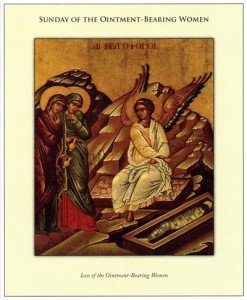By Your resurrection, O Christ our God, You told the women bringing ointment to rejoice;
and You stilled the weeping of Eve, the first mother.
You instructed the women to announce to Your Apostles:
“The Savior has risen from the tomb”.
 On the second weekend of our forty-day celebration of the Resurrection of Christ, the Church would have us remember the story of the Myrrh-Bearers, those women who came to Jesus’ tomb to complete the burial ritual for Him. The burial ritual had not been completed since it was the Sabbath. There was, and still is, an elaborate ritual which can be carried out for the burial of devout Jewish people.
On the second weekend of our forty-day celebration of the Resurrection of Christ, the Church would have us remember the story of the Myrrh-Bearers, those women who came to Jesus’ tomb to complete the burial ritual for Him. The burial ritual had not been completed since it was the Sabbath. There was, and still is, an elaborate ritual which can be carried out for the burial of devout Jewish people.
It is obvious from the fact that the women went to complete the burial ritual that they did not expect Him to be raised from the dead. In all four Gospel accounts, it is obvious that the women had no real expectation that Jesus would rise from the dead. All four accounts, however, indicate that it was the women followers of Jesus who first discovered His resurrection. In fact, Mary Magdalene is the one woman who is consistently mentioned in all of the accounts.
The resurrection narratives in the gospels do not derive directly from the early stage when the apostolic testimony was as yet unchallenged by unbelievers. They reflect a somewhat later period, when the average Christian was aware of the principal counter-arguments of unbelievers against the doctrine of the resurrection; namely, that Jesus’ disciples had removed his body from the tomb, or that they were victims of visionary or other objectively unreal experiences. The gospels and the tradition that preceded them carefully interwove the data of the resurrection with the replies to these arguments so that Christians might remain in possession of their faith.
The narratives then, begin with the account of the women’s visit to the tomb – no doubt to make clear that up to this point the male disciples of Jesus had not come near the tomb. The reaction of the disciples to the women’s report reveals that they did not anticipate Jesus’ immediate resurrection, much less think of creating a resurrection myth by removal of the body. The stress on the incredulity of the disciples depicts them as men not easily convinced of the resurrection event. They thought, at first, that they were seeing a ghost. The greater problem of the disciples in accepting the fact of the resurrection was, no doubt, its messianic implications. I wonder how we would act if we had been there?
